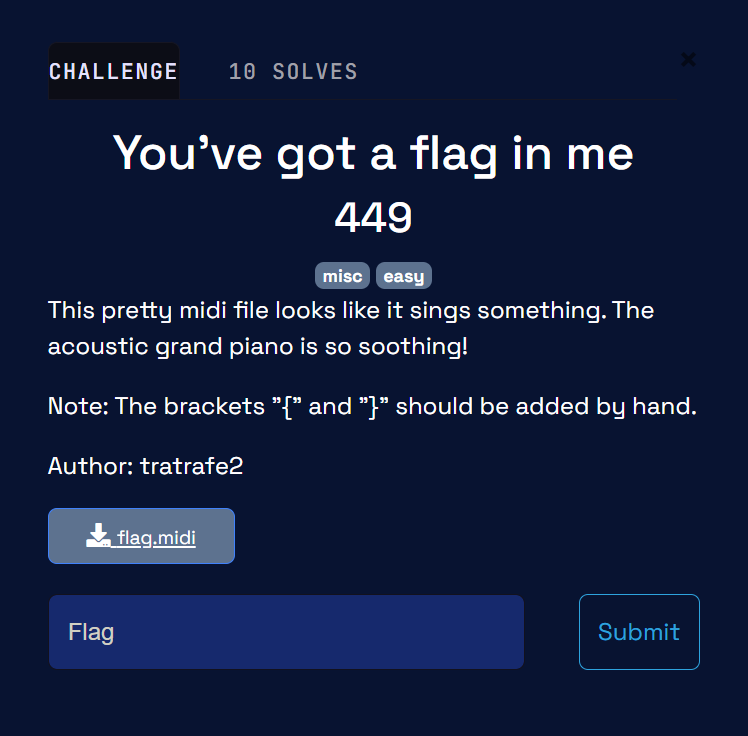You've got a flag in me
“That’s what she said”
For CCSC’s CTF, I encountered a fun “misc” challenge involving a MIDI file. The description teased: “This pretty midi file looks like it sings something. The acoustic grand piano is so soothing!” The flag format was ECSC{…}, and I needed to find the hidden message encoded in the MIDI.
My first instinct was to poke around with file and strings. I spotted a suspicious-looking “KEY” array in the file:
1
2
kr7pt0@kr7pt0~$ file flag.midi
flag.midi: Standard MIDI data (format 0) using 1 track at 1/240
1
2
3
4
kr7pt0@kr7pt0~$ strings flag.midi
MThd
MTrk
KEY=[7,58,391,58,129,80,537,80,389,33,80,107,522,391,389,148,386,522,389,58,240,240,107,1]
Clearly, this was meant for something! I then opened the MIDI with Python’s mido to see what instruments and notes were present.
By examining the MIDI data, I learned that only channels without a program_change are set to the acoustic grand piano (program 0) by default. In this file, channel 2 fit the bill, and, crucially, it also contained note data.
The phrase “so soothing” from the description got me thinking, maybe only notes played “gently” were important? In MIDI, a note_on event with velocity zero actually signals the end of a note (essentially a note_off). Could this be the key? I wrote a script to extract all notes from channel 2 where the velocity was exactly 0.
At this point, my approach seemed logical, but I still had the mysterious KEY array and wasn’t sure how it fit in. After about 15 minutes of staring at my ceiling, inspiration struck: the first four numbers in the key 7, 58, 391, 58 lined up interestingly with the expected flag prefix ECSC. In particular, the fact that both the third and fourth flag letters are “C” and the key repeats “58” caught my attention—maybe the numbers were indexes?
I scrolled through my list of extracted notes with velocity 0 and checked the note at index 58. When I converted it to ASCII, the letter “C” appeared—bingo! From there, I wrote a simple Python script to automate extracting all the key-indexed notes and decoding the flag.🎉🎉🚩
1
2
3
4
5
6
7
8
9
10
11
12
13
14
15
16
17
18
19
20
21
22
23
24
25
26
27
28
29
30
31
32
from mido import MidiFile
# The KEY as given in the challenge
KEY = [7,58,391,58,129,80,537,80,389,33,80,107,522,391,389,148,386,522,389,58,240,240,107,1]
mid = MidiFile('flag.midi')
zero_velocity_notes = []
# 1. Collect note numbers from note_on (channel 2, velocity 0)
for msg in mid:
if msg.type == 'note_on' and msg.channel == 2 and msg.velocity == 0:
zero_velocity_notes.append(msg.note)
# 2. Use KEY as index to extract the flag notes
flag_notes = []
for idx in KEY:
if idx < len(zero_velocity_notes):
flag_notes.append(zero_velocity_notes[idx])
else:
flag_notes.append(None)
# 3. Print result as both note numbers and ASCII
print("Extracted note numbers:")
print(flag_notes)
print("\nAs ASCII characters (where printable):")
flag_string = ""
for n in flag_notes:
if n is not None and 32 <= n <= 126:
flag_string += chr(n)
else:
flag_string += '?'
print(flag_string)
1
2
kr7pt0@kr7pt0~$ python3 sol.py
ECSC{M1D1_F1L3S_4R3_C00L!}
